ma.gif) image located by Vanja Poposki, 15 October 2019
image located by Vanja Poposki, 15 October 2019
Last modified: 2025-12-19 by rob raeside
Keywords: maykopsky district |
Links: FOTW homepage |
search |
disclaimer and copyright |
write us |
mirrors
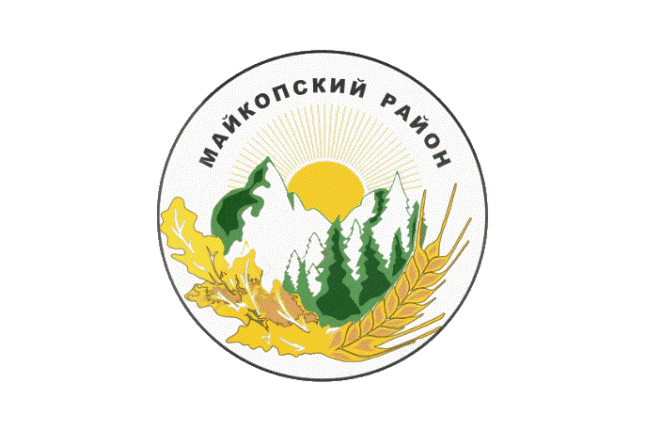 image by Victor Lomantsov, 13 December 2025
image by Victor Lomantsov, 13 December 2025 Maykopskiy rayon was created in 1924 in then Maykopskiy Okrug in then
South East Oblast. Later same year it became part of North Caucasus Kray.
There were several more changes in the rayon, but it became part of
Adygeyskaya Autonomous Oblast in 1962.
Valentin Poposki, 15 October 2019
Maykopskiy County in Adygeya uses unofficial flags - one is white with the
county emblem on it, for various manifestations where it participates. The image
is taken from the official page of the Administration of Teuchezhskiy County in
vkontakte.ru.
https://www.vexillographia.ru/russia/subjects/towns/maikop1.htm
Valentin Poposki, 13 December 2025
ma.gif) image located by Vanja Poposki, 15 October 2019
image located by Vanja Poposki, 15 October 2019
There are no coat of arms and flag for this rayon. However, in 2006 the
rayon's authorities adopted an emblem.
Vanja Poposki, 15 October 2019
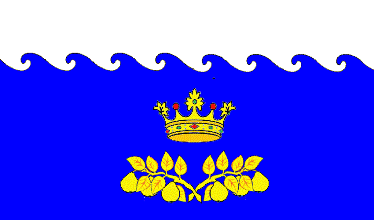 image located by Vanja Poposki, 25 November 2019
image located by Vanja Poposki, 25 November 2019
Abadzekhskoe Sel'skoe Poselenie has no official symbols. I attach projects
found in Heraldicum and Vexillographia websites.
Vanja Poposki, 25
November 2019
aba.gif) image located by Vanja Poposki, 25 November 2019
image located by Vanja Poposki, 25 November 2019
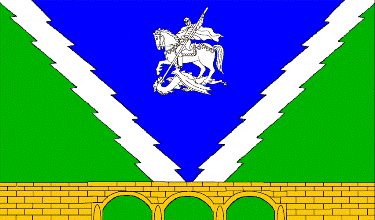 image located by Vanja Poposki, 25 November 2019
image located by Vanja Poposki, 25 November 2019
Dakhovskoe Sel'skoe Poselenie has no official symbols. I attach projects
found in Heraldicum and Vexillographia websites.
Vanja Poposki, 25
November 2019
dah.gif) image located by Vanja Poposki, 25 November 2019
image located by Vanja Poposki, 25 November 2019
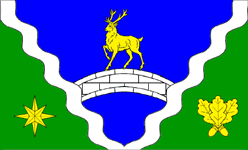
 images located by Vanja Poposki, 25 November 2019
images located by Vanja Poposki, 25 November 2019
Kamennomostskoe Sel'skoe Poselenie has a coat of arms and flag, adopted in
2013. Description of the flag: The flag is a rectangular panel with a 2: 3 ratio of width to length, depicting the figures of the coat of arms of the Kamennomostsky rural settlement in green,
blue, white, yellow and black. Adopted on 18.06.2013.
Vanja Poposki, 25
November 2019
kam.gif) images located by Vanja Poposki, 25 November 2019
images located by Vanja Poposki, 25 November 2019
Description of the coat of arms: In a green field, a silver overturned wavy rafter filled with azure, in which there is a silver bridge with black lining, along which a golden deer runs, and accompanied by heraldically large and small golden rusticated four-beam,
folded in an indirect cross, stars and heraldically to the left - golden oak trefoil with two acorns. The emblem is crowned with a three-pronged gold crown of a standard set for rural settlements. The image of the coat of arms without a crown is allowed.
The silver wavy rafter symbolizes the numerous rivers, streams and waterfalls of the settlement, including the Belaya, Meshoko and Rufabgo rivers, as well as the snow-capped peaks of the Main Caucasus Range at the foot of which the settlement is located.
The Silver Bridge allegorically points to a natural monument - the Hadzhokh Gorge, in which there was a natural stone bridge, which gave the name to the settlement. In addition, the masonry of the bridge indicates the extraction and processing of limestone and other building materials in the settlement. The bridge in heraldry is a symbol of the connection of the past and the future.
Deer is a symbol of beauty, nobility. The image of a deer in the coat of arms of the settlement indicates that these noble animals live in the forests of the settlement. Deer has been known in these places since ancient times, as indicated by archaeological excavations carried out on the territory of the settlement, in which objects bearing the image of this animal were found. The Adyghe name of the Belaya River "Shkhaguasche" is translated as "the princess of deer." The image of the deer also allegorically points to the 44th Nizhny Novgorod Dragoon Regiment, whose soldiers became one of the founders of the present village of Kamennomostsky, and whose regimental sign depicts a deer from the coat of arms of the city of Nizhny Novgorod.
An eight-pointed rusticated star indicates that the village is the center of tourism in the Republic of Adygea, known far beyond its borders. Three oak leaves - according to the number of settlements, in addition, oak is a sacred tree, both among the Slavs and Circassian Circassians, a symbol of longevity and power, glory, valor, and not only military but also labor .. The
green color symbolizes nature, fertility, life, rebirth and health, and also allegorically indicates the mountain forests surrounding the village and the gardening developing in the village.
Blue (light blue) - symbolizes beauty, softness, peaceful sky, allegorically points to the first settlers of the Kamennomostskoe rural settlement municipality, immigrants from the Caucasian Linear and Orenburg Cossack troops who founded the village of Kamennomostska.
Silver symbolizes the purity of mountain rivers, nobleness, hope, truthfulness, and also allegorically indicates the extraction and processing of building materials in the settlement, primarily stone limestone.
Gold allegorically indicates the inexhaustible natural wealth of the settlement, greatness, prosperity and prosperity, strength, and also speaks of the fidelity, glory and merit of the inhabitants of the settlement.
Black color - chastity, honesty, impeccability, allegorically indicates the Orthodox St. Michael's Mount Athos Zakuban Desert, located on the territory of the settlement. Adopted on 18.06.2013.
Vanja Poposki, 25
November 2019
 image located by Vanja Poposki, 25 November 2019
image located by Vanja Poposki, 25 November 2019
Kirovskoe Sel'skoe Poselenie has no official symbols. I attach projects
found in Heraldicum and Vexillographia websites.
Vanja Poposki, 25
November 2019
kir.gif) image located by Vanja Poposki, 25 November 2019
image located by Vanja Poposki, 25 November 2019
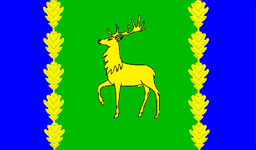 image located by Vanja Poposki, 25 November 2019
image located by Vanja Poposki, 25 November 2019
Krasnooktyabr'skoe Sel'skoe Poselenie has no official symbols. I attach projects
found in Heraldicum and Vexillographia websites.
Vanja Poposki, 25
November 2019
kra.gif) image located by Vanja Poposki, 25 November 2019
image located by Vanja Poposki, 25 November 2019
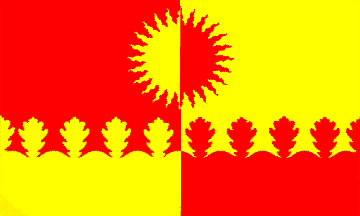 image located by Vanja Poposki, 30 November 2019
image located by Vanja Poposki, 30 November 2019
Krasnoul'skoe sel'skoe poselenie has no official symbols. Attached are
projects for coat of arms and flag.
Vanja Poposki, 30
November 2019
kru.gif) image located by Vanja Poposki, 30 November 2019
image located by Vanja Poposki, 30 November 2019
![]() image located by Vanja Poposki, 30 November 2019
image located by Vanja Poposki, 30 November 2019
Kuzhorskoe sel'skoe poselenie obviously has official symbols, but are hard to
find. Here is banner of the official website which contains the coat of arms.
Vanja Poposki,
30
November 2019
pob.gif) image located by Vanja Poposki, 30 November 2019
image located by Vanja Poposki, 30 November 2019
Pobedenskoe Sel'skoe Poselenie has no official symbols. I attach projects
found in Heraldicum and Vexillographia websites.
Vanja Poposki, 30
November 2019
Timiryazevskoe Sel'skoe Poselenie has no official symbols.
Vanja Poposki, 30
November 2019
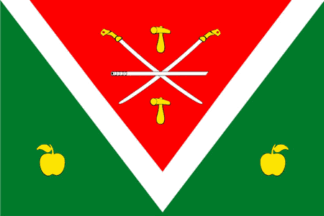 image by Tomislav
Šipek, 26 November 2019
image by Tomislav
Šipek, 26 November 2019
Here is flag of Tulsky in Maykopsky district. Description of the flag: A rectangular panel with a 2: 3 ratio of width to length,
reproducing the composition of the coat of arms of the Tula city settlement in green, red, white and yellow. The flag of the Tula city settlement reflects its historical and cultural traditions, as well as natural and geographical features.
The administrative center of the Tula city settlement - the village of Tula was founded in 1862 as the village of Egerukhaevskaya. The village had the status of a village for more than a hundred years. In addition, the founders of the village were, in their majority, the Kuban Cossack family, this is reflected on the flag with two silver, gold handles upwards drawn bosoms crosswise.
In 1867, with the consent of Emperor Alexander II, the village of Egerukhaevskaya was renamed Tula in honor of the 72nd Tula Infantry Regiment, formerly located in the Caucasus, which is reflected on the flag of the Tula City Settlement with elements from the coat of arms of the Tula Infantry Regiment - two golden malts (wooden mallets) and silver rifle barrel.
The silver rafter symbolizes the Belaya River, flowing through the territory of the settlement and originating in the Caucasus Mountains.
Golden apples symbolize the tract Maikop located on the territory of the settlement and the small river of the same name, the banks of which were once covered with many wild apple trees. Maykop in translation into Russian means - the mouth of the "apple" river. It was in this place that the name of the capital of the Republic of Adygea, the city of Maykop, got its name in the 19th century.
Red color is a symbol of beauty, courage and strength.
Green color symbolizes hope, nature, life, health.
Yellow color (gold) is a symbol of strength, strength, generosity, sunlight and dawn.
White color (silver) is a symbol of simplicity, perfection, nobility, peace. Adopted on 31.05.2011.
https://tulskiyposelok.ru/?article_id=3655
https://tulskiyposelok.ru/?cat_id=622
Tomislav Šipek, 26 November 2019
tul.gif) image located by Vanja Poposki, 30
November 2019
image located by Vanja Poposki, 30
November 2019
Tul'skoe sel'skoe poselenie has official coat of arms and flag, adopted in
2011. Description of the coat of arms: In a green field, an overturned silver rafter filled with a scarlet encumbered with two silver, gold handles upward naked Cossack (Caucasian) checkers crosswise,
on top of which a silver rifle barrel in belt, accompanied by two gold hammers (wooden hammers) at the top and bottom, to the right and to the left of the rafter below one golden apple. The coat of arms and the flag of the settlement are based on the image on the badge of the 72nd Tula Infantry Regiment, which coincides with the historical emblem of the city of Tula, with minor changes - instead of rifle trunks, Cossack drafts were used, the silver rafters of the Belaya and Maykopka rivers, at the confluence of which arose Tula village. Green is the color of the forests and gardens surrounding the current village of Tula. Two golden apples are a symbol of two settlements of the Tula rural settlement - the village of Tula and the small village of Makhoshepolyan. Apples also point to the Maikopka river, along which part of the Belaya River valley from the current village of Tula to the city of Maykop, in Russian military sources was referred to as the Maykop gorge. “Maykop” - from the Circassian “myekyuape” - “the mouth of the valley of apple trees”.
Red, white, gold colors, in addition to traditional meanings, indicate a connection with the Russian Federation, green and gold (colors of the Adygea flag) indicate a connection with the Republic of Adygea. Adopted on 31.05.2011.
Vanja Poposki, 30
November 2019